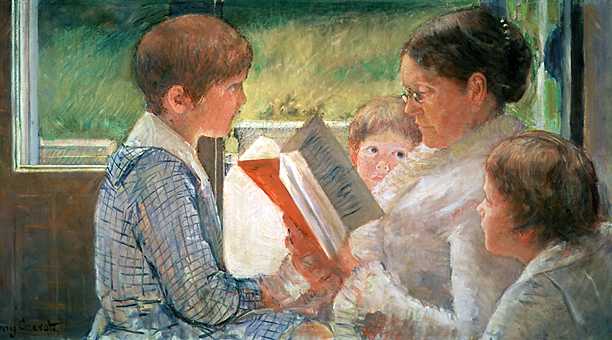Reading Series Part II: Reading WITH Children
Reading Series Part III: Reading BY Children

Last summer our family went to a lecture by Dr. Brad Wilcox at our library to learn about reading. He taught us some really interesting things about why reading to kids is important and also how to get kids to enjoy reading and to read for pleasure. I wanted to share the things he said because I think they are very valuable. Reading is the foundation of all learning and children should be taught from infancy to love books and reading.
There are three stages of reading: To, with, and by.
Reading TO Children
We learn a lot of things by watching what others do. Children learn by watching their parents. Modeling the behavior you want your children to adopt is the best way to ensure that they will adopt it. Kids should both see their parents reading and parents should read to their children.
Bedtime is the perfect time to read to kids. Things are busy throughout the day, but right before bedtime should be a calm and relaxing time to be together as a family and to transmit family values and teachings.
One of the biggest benefits of reading aloud to children relates to vocabulary. Reading aloud helps kids learn more about vocabulary and the flow of language. Dr. Wilcox said that vocabulary in American children as dropped 15,000 words wince 1945! That’s remarkable, but not surprising. With technological advances people are reading less and therefore losing vocabulary.
As a parent concerned with your child’s education and overall intelligence level, don’t let the TV take over. Reading is a mentally active exercise or leisure activity while watching TV is passive. There is a place for both, but kids really need more mental activity than mental passivity. It’s important to balance relaxation with mind stimulation. Reading makes your mind work and that is essential!
Reading is great for developing stamina and attention span. Kids who are read to are better able to sit still and pay attention for longer periods of time. Reading aloud to kids gives them the ability to sit and listen to a story, which expands their overall attention span.
Reading aloud also increases comprehension, fluency, and phonemic awareness. Phonemic awareness is the awareness of sounds and is taught commonly through songs and nursery rhymes, jump rope jingles, and poems.
To get your child more involved, ask questions before you begin and as you are reading the book. Here are some examples:
- Based on the cover, what do you think the story is going to be about?
- Based on the title, what do you think the story is going to be about?
- Who is the story about?
- How do you think the character felt when that happened to him?
- How do you think the story will end?
- What do you think comes next?
- What would you do if you were that character?
- What do you like about the character?
- What was your favorite part about the book?
- What could the character have done differently to change the outcome of the book?
- How did you feel when that happened?
- What is another way the story could have ended?
- What do you think might happen to the character later in his life?
- Is this story like any other story you’ve read?
Reading aloud to children is essential to their cognitive development and their acquisition of new vocabulary. Kids who are read to often have a greater span of background knowledge and are therefore able to understand anything easier than a child with little or no background knowledge. Being a good reader almost guarantees academic and educational success, and it all starts with being read to.
[photo from www.elmhurst.edu/~susanss/




{ 3 comments… read them below or add one }